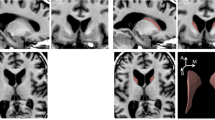Summary
Caudate nucleus atrophy occurs in Huntington's disease and methods of measuring this have been described using axial CT, but these are indirect and lack sensitivity. We measured caudate nucleus area (blind to the subjects' clinical state) in 30 subjects with or at risk of Huntington's disease, and in 100 normal age matched controls. Fifteen subjects with established symptomatic Huntington's disease, 3 with early symptoms, and 3 presymptomatic subjects (2 showing a high probability for the Huntington's disease gene on genetic testing, and one who has since developed symptoms) were correctly identified. Three normal (gene negative) family members were also correctly identified. Outcome is awaited in 6. CT caudate area measurement is simple and reproducible and we have found it to be a useful confirmatory test for Huntington's disease.
Similar content being viewed by others
References
Hayden MR (1981) Huntington's chorea. Springer, Berlin Heidelberg New York
De la Monte SM, Vonsattel J-P, Richardson EP (1988) Morphometric demonstration of atrophic changes in the cerebral cortex, white matter and neostriatum in Huntington's disease. JNEP 47:516–525
Vonsattel J-P, Myers RH, Stevens TJ, Ferrante RJ, Bird ED, Richardson EP (1985) Neuropathological classification of Huntington's disease. JNEP 44:559–577
Myers RH, Sax DS, Schoenfeld M, Bird ED, Wolf PA, Vonsattel J-P, White RF, Martin JB (1985) Late onset of Huntington's disease. JNNP 48:530–534
Smurl JF, Weaver DD (1987) Presymptomatic testing for Huntington chorea: guidelines for moral and social accountability. Am J Med Genet 26:247–257
Harper PS, Morris MJ (1989) Predictive testing for Huntington's disease. BMJ 298:404–405
Barr AM, Heinze WJ, Dobben GD, Valvassoni GE, Sugar O (1978) Bicaudate index in computerised tomography of Huntington disease and cerebral atrophy. Neurology 28:1196–1200
Stober T, Wussow W, Schimrigk K (1984) Bicaudate diameter-the most specific and simple CT parameter in the diagnosis of Huntington's disease. Neuroradiology 26:25–28
Starkstein SE, Folstein SE, Brandt J, Pearlson GD, McDonnell A, Folstein M (1989) Brain atrophy in Huntington's disease. Neuroradiology 31:156–159
Terrence CF, Delaney JF, Alberto MC (1977) Computed tomography for Huntington's disease. Neuroradiology 13:173–175
Sax S, Menzer L (1977) Computerised tomography in Huntington disease. Neurology 27:388
Shoulson I, Plassche W (1980) Huntington disease: the specificity of computed tomography measurements. Neurology 30:382–383
Neophytides AN, Chiro GD, Barron SA, Chase TN (1979) Computed axial tomography in Huntington's disease and persons at risk for Huntington's disease. Adv Neurol 23:185–191
Hayden MR, Hewitt J, Stoessl AJ, Clark C, Ammann W, Martin WRW (1987) The combined use of positron emission tomography and DNA polymorphism for preclinical detection of Hungtington's disease. Neurology 37:1441–1447
Berent S, Giordani B, Lehtinen S, Markel D, Penney JB, Buchtel HA, Starosta-Rubinstein S, Hichwa R, Young AB (1988) Positron emission tomographic scan investigations of Huntington's disease. Cerebral metabolic correlates of cognitive function. Ann Neurol 23:541–546
Simmons JT, Pastakia B, Chase TN, Shults CW (1986) Magnetic resonance imaging in Huntington's disease. AJNR 7:25–28
Nagel JS, Johnson KA, Ichise M, English RJ, Walshe TM, Morris JH, Holman BL (1988) Decreased 1123 IMP caudate nucleus uptake in patients with Huntington's disease. Clin Nuc Med 13: 486–490
Folstein SE, Jensen B, Leigh BJ, Folstein MF (1983) The measurement of abnormal movement: methods developed for Huntington's disease. Neurobehav. Toxicol Teratol 5:605–609
Stein RA, Pearce KI, Nosil J, Strecker TC (1985) Toward quantitative characterisation of the caudate nucleus through CT image enhancement. J CAT 9:708–714
Author information
Authors and Affiliations
Rights and permissions
About this article
Cite this article
Wardlaw, J.M., Sellar, R.J. & Abermethy, L.J. Measurement of caudate nucleus area —A more accurate measurement for Huntington's disease?. Neuroradiology 33, 316–319 (1991). https://doi.org/10.1007/BF00587814
Received:
Issue Date:
DOI: https://doi.org/10.1007/BF00587814




